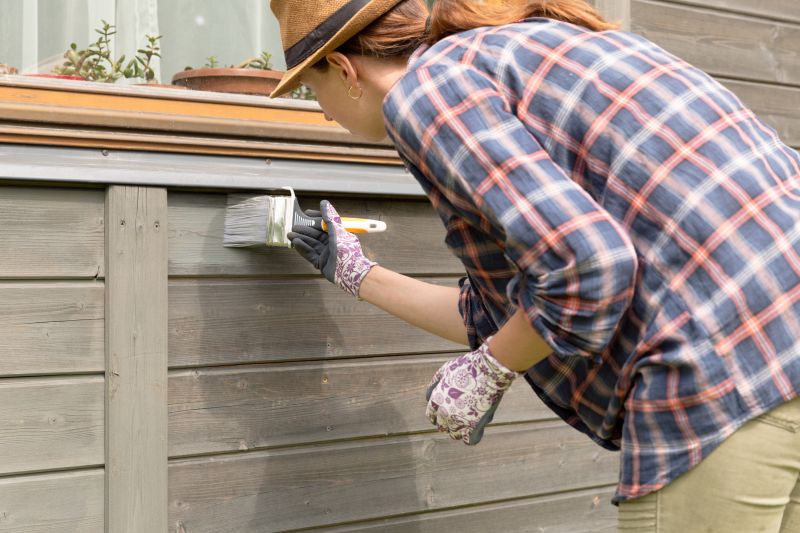Favorite Products For Wood Siding Paintings For Easy Application
Get insights into user-approved tools and materials that simplify the process of painting wood siding.
 When selecting products for wood siding paintings, it is essential to consider items that enhance the visual appeal while providing adequate protection for the wood surfaces. These products often include a variety of paints, stains, and sealers designed specifically for outdoor wood applications. They are formulated to withstand weather elements such as rain, sun exposure, and temperature fluctuations, helping to preserve the integrity and appearance of painted wood siding over time.
When selecting products for wood siding paintings, it is essential to consider items that enhance the visual appeal while providing adequate protection for the wood surfaces. These products often include a variety of paints, stains, and sealers designed specifically for outdoor wood applications. They are formulated to withstand weather elements such as rain, sun exposure, and temperature fluctuations, helping to preserve the integrity and appearance of painted wood siding over time.
Top Overall Option
Premium Exterior Wood Paint
A high-quality exterior wood paint designed to provide a durable, weather-resistant coating that enhances the natural beauty of wood siding. It offers excellent adhesion, color retention, and ease of application, making it suitable for various wood types and finishes.
Types of Products For Wood Siding Paintings
Acrylic Exterior Paint
Water-based paint that offers ease of application, quick drying, and good color retention for wood siding projects.
Oil-Based Exterior Paint
Provides a durable finish with excellent adhesion and resistance to weathering, suitable for long-lasting projects.
Wood Stain
Penetrates the wood surface to highlight natural grain while adding color and protection against the elements.
Clear Sealant
Transparent protective coating that preserves the natural look of wood while providing weather resistance.
Semi-Transparent Stain
Adds color while allowing wood grain to show through, offering a balance between protection and appearance.
Solid Color Primer
Prepares wood surfaces for painting by sealing knots and ensuring uniform color coverage.
High-Gloss Finish
Provides a shiny, reflective surface that enhances color vibrancy and surface durability.
Matte Finish
Offers a non-reflective, subdued appearance suitable for a softer aesthetic.
Textured Coating
Creates a textured surface for decorative or protective purposes, adding visual interest.
Elastomeric Coating
Flexible coating that can bridge minor cracks and withstand movement in wood siding.
Milky White Primer
Opaque primer that helps in achieving uniform color and enhances adhesion of top coats.
Eco-Friendly Paint
Low-VOC or VOC-free options designed for environmentally conscious projects.
Anti-Mildew Coating
Specialized coating to prevent mold and mildew growth on exterior wood surfaces.
Bonding Primer
Primers formulated to adhere well to difficult surfaces or existing coatings for better paint adhesion.
Rust-Inhibitive Primer
Prevents rust formation on any exposed metal components associated with wood siding structures.
Popular Choices
Widely used for its ease of application, quick drying, and versatility across various wood siding projects.
Favored for its durability and resistance to harsh weather conditions, suitable for long-term projects.
Popular for highlighting wood grain while adding color and protection against outdoor elements.
Chosen for preserving the natural look of wood while providing a weather-resistant barrier.
Selected for projects requiring a shiny, vibrant surface with added durability.
Preferred for achieving a non-reflective, understated appearance on wood siding.
Used to create decorative textures or to add a layer of protection with visual interest.
Popular for flexible coverage that can accommodate minor wood movements and cracks.
Commonly used to improve adhesion on challenging surfaces or existing coatings.
Chosen for preventing mold or mildew growth in damp or shaded areas.
Popular among environmentally conscious homeowners for low-VOC formulations.
Used to protect any metal fixtures or fasteners in contact with wood siding.
Choosing the right products involves understanding the different types of finishes available. Paints generally offer a solid, opaque coating that can completely cover the wood surface, providing vibrant color and uniform appearance. Stains, on the other hand, penetrate the wood to highlight its natural grain while adding color and protection. Sealers and topcoats serve to lock in the color, add durability, and provide a smooth or textured finish based on aesthetic preferences.
Proper preparation of the wood surface prior to painting or staining is crucial for optimal results. This includes cleaning, sanding, and sometimes priming, to ensure the product adheres well and lasts longer. Additionally, selecting products with good coverage and ease of application can make the painting process more efficient and enjoyable. Regular maintenance with suitable touch-up products can help maintain the appearance of wood siding paintings for years to come.
Overall, the choice of products for wood siding paintings should align with the specific needs of the project, including the type of wood, desired appearance, and environmental conditions. Investing in quality products can facilitate a more durable and attractive finish, enhancing the overall look of any wood-sided structure.
Key Buying Considerations
- Type of finish desired (gloss, matte, semi-gloss) to match aesthetic preferences.
- Weather resistance capabilities suitable for your local climate conditions.
- Compatibility with existing coatings or bare wood surfaces.
- Ease of application, including drying time and coverage per coat.
- Durability and longevity of the coating in outdoor environments.
- Ease of maintenance and touch-up requirements over time.
- Color retention and resistance to fading from sunlight exposure.
- Compatibility with other protective products like primers and sealants.
- Application methods supported, such as brush, roller, or sprayer.
- Presence of VOCs or other chemicals based on health and safety considerations.
- Cost and value proposition relative to the coverage and durability offered.
- Specific needs for highlighting natural wood grain or providing opaque coverage.
- Resistance to mold, mildew, and algae growth in humid conditions.
- Availability of matching touch-up products for ongoing maintenance.
- Brand reputation and user reviews for consistency and reliability.
